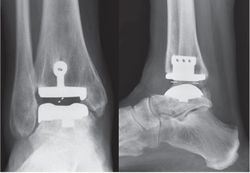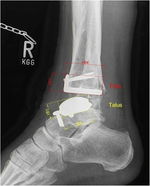Ankle replacement surgery
There will be three different subjects in this report which are the surgery procedures, types of recovery, and the description. The description is of what an ankle replacement is and what materials are used to replace the ankle or other bone. The surgery procedure is what you can and cannot do or take leading up to the operation, which includes not being able to eat or drink anything for six to twelve hours. The last of the three is the types of recovery. The section about types of recovery talks about the different kinds of activities that may be used to strengthen the muscles and joints that were affected during the ankle replacement surgery.
Causes
These procedures are done most often due to rheumatoid arthritis, infections, bone fractures, osteoarthritis, arthritis, and bone chips. There are risks to having ankle replacement surgery as well as any surgery. The risks of any surgery involving anesthesia can include: internal bleeding, blood clots, breathing issues, infections and possible allergic reactions. More specifically, ankle replacement surgeries can cause scarring, nerve damage, feebleness of the ankle, a rejection (most often an allergic reaction) of the artificial joint by the body, the artificial joint may become loose over a certain period of time depending on certain factors, bones sometimes break during the surgeries, and the artificial joint may also become dislocated. These are the most common risks that may result from having ankle replacement surgery. Generally when people have ankle replacement surgery they are put under general anesthesia which means they are given a certain kind of gas that puts them to sleep. Another option is spinal anesthesia which instead of putting you asleep it numbs your body to the waist and below. In order to expose the ankle joint the surgeon will have to make an incision in the front of the ankle. Once the ankle joint is exposed, the tendons, blood vessels, and muscle will be delicately moved aside.[1]
Surgery
Some of the procedures for an ankle replacement, are that you cannot drink or eat anything six to twelve hours before the operation is performed, they will only allow you to drink a sip of some water to take any type of drugs you take on a normal basis. They will not let you take drugs like any kind of pain reliever like aspirin, ibuprofen, and naproxen (also known as Aleve). All of these pain relievers are known to make it more difficult for your blood to clot.[2] The surgeon will make an incision in the side and front of the ankle and then they will remove the damaged bones. The surgeon will then smooth out the cartilage and bone where they took the damaged bone out and then he replaces your joint with metal and/or plastic.[3]
Recovery
Much similar too other procedures there are many different types of recovery, such as stretching, strengthening, and the use of aerobic exercises. Stretching is part of the process to recovering your range of motion in the ankle joint. Strengthening also helps the muscles get used to being used again after a long process of recovery. Aerobic exercise is used to help patients walk without putting too much stress on the ankle as much as running or jogging would put too much stress on the ankle you had an ankle procedure on. After doing aerobic exercises for awhile you can slowly increase the amount of activity involving the ankle.[4]
References
- ↑ Ma, Benjamin. Ankle replacement MedlinePlus. Web. March 5, 2015. (Date-reviewed).
- ↑ Ma, Benjamin. Ankle replacement MedlinePlus. Web. March 5, 2015. (Date-updated)
- ↑ Nazario, Brunilda. What You Need to Know About Ankle Replacement WebMD. Web. January 16, 2015. (Date-reviewed)
- ↑ Zelman, David. What You Need to Know About Ankle Replacement WebMD. Web. January 21, 2015 (Date-reviewed)
| ||||||||||||||||||||


